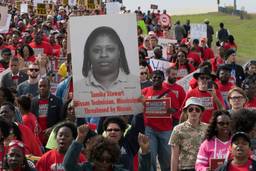Not Your Parents’ Labor Movement
Why the Republic sit-in failed to inspire other worker actions.
David Moberg

Workers of Chicago-based Republic Windows and Doors captured the nation’s attention when they occupied their workplace for six days last December. Their employer gave only three days notice of the plant’s closing and showed no intention of paying their accrued vacation pay or two months of back wages, as is legally required after a notice of closing.
Republic’s bank, the publicly salvaged Bank of America, refused to extend credit to the company. In response, the 250 workers, mainly Latino and African-American, occupied the plant from December 5 to 10, preventing the company from moving the machinery out, until they received what they were owed.
Support poured in – from other unions, community groups, religious leaders and even president-elect Obama. Images of sit-down strikes from the Great Depression came to mind as the Great Recession deepened. Many observers thought Republic might be a harbinger of a new wave of labor militancy.
“These workers are to this struggle perhaps what Rosa Parks was to social justice 50 years ago,” Rev. Jesse Jackson told a rally at the plant. “This, in many ways, is the beginning of a larger movement for mass action to resist economic violence.”
A lackluster response
More than half a year later, that larger movement hasn’t materialized. Why not? It’s not for lack of reasons. Employers continue to shut down workplaces, cut wages and fight pro-union legislation. Workers in other countries frequently take direct action to fight job losses. French factory workers hold managers hostage. Brazilian and Argentine workers seize and operate businesses and, in June, British energy workers went on an unauthorized national strike.
The Republic sit-in has reverberated elsewhere, but only faintly:
—Workers at two Hartmarx men’s clothing factories in Illinois and New York voted in May to stage a sit-in if the bankrupt company and its uncooperative bank, Wells Fargo, failed to sell to a buyer who would continue production in its domestic factories. (In June, the company announced it would sell to such a buyer, Emerisque.)
—At Quad-City Die Casting in Moline, Ill., workers are protesting Wells Fargo’s refusal to lend to their employer, which could eliminate 100 jobs at the 60-year-old family-owned precision-parts maker. Quad-City employees, who belong to United Electrical Workers (UE), the proactive union that also represents Republic Windows and Doors workers, are considering a sit-in to prevent their plant’s closing.
—In April, Southern Californian warehouse workers at a distribution center for mega-retailers staged sit-ins at a temporary staffing agency and blocked a prominent intersection. These actions – organized by Warehouse Workers United, a project of the Change to Win labor federation – aimed to win organizing rights for warehouse workers and force companies such as Target and Wal-Mart to make sure that the contractors who staff the warehouses properly pay the largely temporary workforce.
Apart from these examples, few protests – let alone sit-ins – have occurred in response to widespread lay-offs and factory closings.
Republic workers were able to win due to some very specific conditions. The UE has a long history of leftist leadership. Five years ago, it helped workers throw out an ineffective “mobbed up” union. They’ve nurtured strong local leaders who have twice since brought members close to striking. The workers had a legitimate demand: Pay us what we’re owed. (Only after their victory did they begin a successful initiative to keep the plant open through a sale to Serious Materials, a producer of energy-efficient windows that promised to recognize the union.)
The union targeted two vulnerable institutions: a shady employer and a bailed-out bank refusing to make loans, thus generating publicity and support in a strongly unionized city.
One-of-a-kind issue?
There are many reasons why a new wave of militancy has not yet emerged. “I think Chicago was the aberration,” says Cornell University labor relations professor Richard Hurd. “We have very little tradition of labor militancy.”
Nelson Lichtenstein, a historian at the University of California at Santa Barbara, notes that even during the ’30s, labor militancy increased not when the economy was diving, but when it was rebounding.
Yet since 1980, unions have rarely struck or taken other direct action in either good or bad times. Their current passivity reflects the evolution of American political culture, which has been shaped by corporate and right-wing hostility to workers’ rights and unions.
Elaine Bernard, the director of the Harvard Trade Union Program, says that the rarity of Republic-style sit-down strikes can be explained by the “tremendous repression” in the United States as compared to other countries. “I’m surprised in this country, with the high level of repression, how much is happening.”
The political culture of American workers has also become even more individualistic. When unions were able to win strong contracts after World War II, many workers became comfortable with the gains from conservative business unionism. When the political right gained hegemony after 1980, neither unions nor the Democratic Party effectively mobilized workers as a class.
According to University of Massachusetts sociology professor Eve Weinbaum, when workplaces close, workers tend to blame themselves. As real wages declined in recent decades, workers sought individual solutions: longer work hours, more debt. Even though many ’60s leftists now hold union staff positions, there’s a lack of working-class leftist presence in the workplace to push for action and present an alternative explanation of events.
Workers today are often cynical about what unions or politicians can do for them. Most have little experience taking action themselves, as strikes and new organizing have declined. “The hurt and pain are still there, and you can see anger at executive pay,” sociologist Dan Clawson says. “But people don’t see how something might work and seize the opportunity.”
Labor union shrinkage
As a result of employer hostility, globalization, weak legal protection and unions’ own failures to organize new workers, unions’ share of the workforce and strength has declined. This has led many unions to retrench or find non-confrontational ways to grow. Union leaders and their lawyers often discourage direct action, fearing financial or legal repercussions, according to Bill Fletcher, co-author of Solidarity Divided: The Crisis in Organized Labor and a New Path Toward Social Justice.
In many cases, unions have become closer partners with management than with the general public. Such development of a joint labor-management strategy made the autoworkers, for example, more isolated and vulnerable to attack – and less likely to win better terms in the bailout – even if they had wanted to follow Republic workers’ lead. “Autoworkers were not thinking of taking over plants and producing cars for fear the public would say, ‘We tried to help. To hell with you,’ ” says Bernard, at the Harvard Trade Union Program.
Unions do turn out members to vote disproportionately for Democrats, but labor suffers from a general political demobilization. President Obama inspired hope and political engagement. But Lichtenstein argues that “there tends to be a demobilization of the left when a Democratic president gets elected … There’s a kind of ‘let Obama do it’ attitude.”
During the ’60s, the left pressured Democratic presidents to change course on foreign and domestic policy. Since then, political scientist Sheldon Wolin argues in Democracy Incorporated, the United States has evolved toward what he calls “inverted totalitarianism.” In other words, America imposes a constricted free-market model on policy while creating a controlled illusion of democracy.
Despite the current crisis of capitalism, the leadership of a new Democratic administration and right-wing claims that Obama is a socialist, this free-market economic model still dominates policy. This model denies the legitimacy of unruly democratic demands, such as a movement inspired by the Republic sit-in. A popular movement for economic democracy may develop, but it will need more than the militant disruption of business-as-usual in the workplace. It will require dismantling the debilitating, individualized free-market mindsets of workers, unions, politicians and the American public.
GET INVOLVED:
UEWarehouse Workers United
David Moberg, a former senior editor of In These Times, was on staff with the magazine from when it began publishing in 1976 until his passing in July 2022. Before joining In These Times, he completed his work for a Ph.D. in anthropology at the University of Chicago and worked for Newsweek. He received fellowships from the John D. and Catherine T. MacArthur Foundation and the Nation Institute for research on the new global economy.









